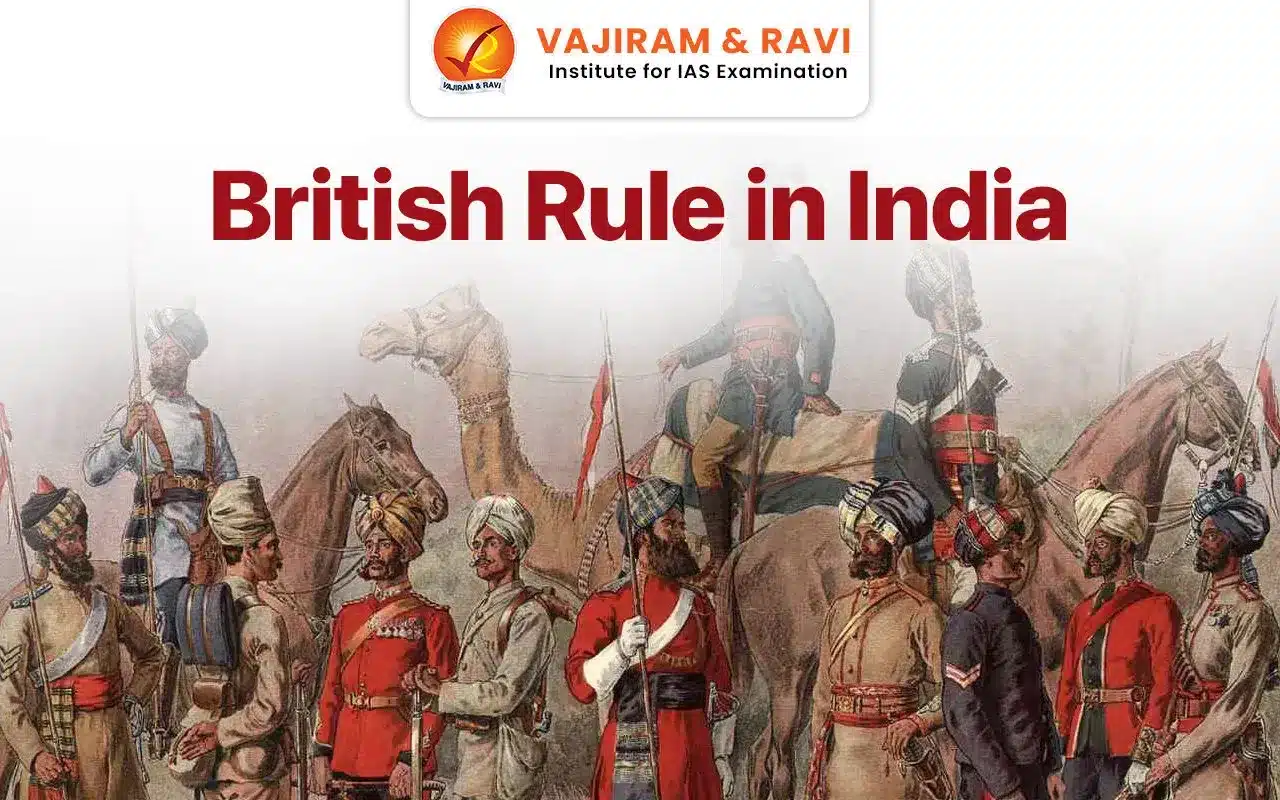The establishment of British rule in India was a gradual process that spanned over several decades. What began as a quest for trade and commerce by the British East India Company eventually led to the formation of a vast colonial empire. Key events like the Battle of Plassey and the Battle of Buxar enabled the company's territorial expansion. The decline of the Mughal Empire and political fragmentation in India aided the British in consolidating power through policies like the Subsidiary Alliance system and Doctrine of Lapse.
Through diplomatic manoeuvring, military force, and the strategic exploitation of the political fragmentation in India, the EIC gradually transformed itself from a trading company into a colonial power, laying the foundation for the eventual establishment of British rule over the Indian subcontinent.
Background of British Raj in India
The success of Portuguese traders influenced the establishment of British rule in India. The lucrative trade prospects led a group of English merchants, known as ‘Merchant Adventurers’, to form the East India Company in 1599 AD.
- Royal Farman: The Royal Farman was a decree issued by the Mughal Emperor granting the EIC the right to trade duty-free. This was a significant milestone in the EIC’s journey, as it allowed them to conduct trade in India without paying customs duties.
- Establishment of Factories: Initially, the Company's focus was on establishing trading outposts and securing favourable trading concessions from the local rulers.
- The EIC's early presence in India was with small trading factories set up along the coast, such as in Surat, Masulipatnam, and Madras.
- Outcompeted other European powers: The EIC managed to outcompete other European powers in the region, securing a dominant position in the Indian subcontinent.
- This was achieved through a combination of superior naval power, strategic alliances with local rulers, and effective company policies.
- Decline of the Mughal Empire: The decline of the Mughal Empire in the late 17th century and the rise of regional powers, such as the Marathas, Mysore, and the Nizam of Hyderabad, etc.
- Political Vacuum: The decline of the Mughal Empire created a political vacuum in India. The defeat of the Marathas in the 3rd Battle of Panipat implied that they were not going to fill this vacuum.
- The British, sensing an opportunity, stepped in to fill this void, gradually expanding their influence and control over the Indian subcontinent.
Early Success of British Rulers in the South
The EIC's first major step toward territorial expansion came in the Carnatic region of southern India, where it engaged in a series of wars with the French East India Company, through the Carnatic Wars between Indian states.
- Carnatic Wars: The conflict between regional powers and the wars of succession (Carnatic wars) created opportunities for the British and French to gain political influence in India.
- These wars reshaped the political landscape, with the British emerging as the dominant European power in India.
- The French suffered setbacks, and Indian powers weakened, setting the stage for future colonial rule.
- Advantages to the British: By the end of the Third Carnatic War, the British became a formidable force by out-competing the French to gain control over the lucrative trade and political influence in the region.
- They learned from the French (especially Dupleix) that internal disputes among Indian kings could be exploited for political gains.
- They applied these experiences in Bengal to achieve further ends in India.
Occupation of Bengal
The EIC's next major stride toward territorial dominance came in the wealthy and strategically important province of Bengal.
- Battle of Plassey (1757): The first significant event was the Battle of Plassey in 1757, which marked a turning point in the EIC's quest for power.
- Leveraging internal rivalries and political intrigue, the EIC's forces led by Robert Clive defeated the army of the Nawab of Bengal, Siraj-ud-Daulah.
- The victory at Plassey allowed the EIC to install its preferred candidate, Mir Jafar, as the new Nawab of Bengal, effectively making the Company the de facto ruler of the province.
- This established the EIC's dominance in Bengal and provided it with a substantial revenue stream, further strengthening its financial and military capabilities.
- Battle of Buxar (1764): In 1764, the EIC faced another significant battle against the combined forces of the Nawab of Bengal Mir Kasim, Nawab of Awadh Shuja-ud-daulah and the Mughal Emperor Shah Alam II at the Battle of Buxar.
- Indian states were forced to sign the Treaty of Allahabad in 1765.
- This treaty enabled the EIC to secure the Diwani (the right to collect revenue) of Bengal, Bihar, and Orissa, effectively making the Company the administrator and tax collector of these provinces and starting the dual government in Bengal.
- Dual Government:
- Under this system, the EIC formally recognised the Nawab of Bengal as the sovereign ruler (Nizamat), while effectively controlling the administration through its control over revenue collection and the judiciary (Diwani).
- This allowed the Company to maintain the appearance of local control while still exerting its authority.
- It was continued till 1773, when Bengal was brought completely under the Company and Warren Hastings was made the first Governor-General.
Expansion of Territories under British Rule in India
The EIC's territorial expansion beyond Bengal was driven by a combination of strategic, political, and economic factors. The Company's expansion was facilitated by the political vacuum in India and the internal conflicts among the Indian Kings.
Conquest of Marathas and Mysore
The British, implementing the policy of "ring-fence", made alliances with Awadh and Nizam (the buffers) to cede territories of Marathas and Mysore respectively.
- Anglo-Maratha Wars: The Anglo-Maratha Wars were three conflicts between the British and the Peshwa and Maratha Confederacy.
- After the Third War(1817-1819), Marathas were defeated.
- Annexation of Mysore: The Treaty of Srirangapatnam (1792) was signed after the Fourth Anglo-Mysore War, which ceded half of Mysore's territory to the British and its allies.
Subsidiary Alliance
Lord Wellesley introduced the subsidiary alliance system in 1798 to bring princely states under British control. It required Indian rulers to maintain British troops within their territories, either by ceding land or paying a subsidy, and host a British Resident.
- This allowed Britain to maintain a large army at the expense of local rulers. The system imposed three major conditions:
- Accept permanent British troops and pay their maintenance costs,
- Obtain British approval before employing Europeans,
- Consult the Governor-General before negotiating with other rulers.
- Some of the prominent states that were incorporated under the Subsidiary Alliance system include - Awadh (the first state to join the alliance through the Treaty of Allahabad), Mysore, Hyderabad, Marathas, Kittur, etc.
Doctrine of Lapse
The Doctrine of Lapse was a policy applied by Lord Dalhousie and implemented by the British East India Company in India during the mid-19th century. This doctrine applied to those statesthat had signed a Subsidiary Alliance with the British.
- It mandated that any princely state or territory under the direct influence of the British East India Company would automatically be annexed if the ruler was either “manifestly incompetent or died without a direct heir”.
- Dalhousie annexed Satara (1848), Jaitpur and Sambalpur (1849), Baghat (1850), Udaipur (1852), Jhansi (1853), and Nagpur (1854), etc. using this Doctrine.
- However, the doctrine was already in use since 1824 when Kittur was annexed.
Conquest of Punjab and Sindh
- Punjab: After the First and Second Anglo-Sikh Wars, the British East India Company gained control over the region.
- Sindh: Strategic plotting by Lord Auckland and the Tripartite Treaty of 1838 facilitated British control over Sindh, culminating in its annexation after the Battle of Miani in 1843.
Occupation of Foreign Territories
- Burma: The British rule in Burma lasted from 1824 to 1948, first as a British India province until 1936 and later independently administered.
- First Anglo-Burmese War (1824-26): The war concluded with the Treaty of Yandabo in 1826. Burma ceded control over Assam, Manipur, and Arakan to the British.
- Second Anglo-Burmese War (1852-53): The war concluded with the Treaty of Pegu. The British gained control over all of lower Burma.
- Third Anglo-Burmese War (1885-86): It resulted in the end of Burma’s independence.
- Balochistan: The Treaty of Gandamak (1879) between the British and Afghans gave the British control over the Bolan Pass and other areas in Balochistan.
- Territories acquired from Nepal: By the Anglo-Nepalese War (Gurkha War)of 1814-16 and the subsequent Treaty of Sugauli, the British ceded Shimla, Sikkim (including Darjeeling), basins of Gandaki and Karnali and the Uttarakhand regions of Garhwal and Kumaon from Nepal.
Control of Administration under British Rule
With the acquisition of the Diwani of Bengal, Bihar, and Orissa, the EIC found itself in the unprecedented position of being both a trading company and a governing authority. This new role necessitated the development of a more structured administrative system to manage the Company's expanding territorial and financial interests.
- Regulating Act of 1773: The first major step in this direction was the Regulating Act of 1773, passed by the British Parliament.
- This act sought to bring the EIC's activities under closer supervision and control by the British Parliament.
- It established a Governor-General (the first being Warren Hastings) to oversee the administration of the Company's territories in India.
- Pitt’s India Act of 1784: The act created a Board of Control in London, composed of the British Cabinet ministers, to supervise the Company's policies and decisions.
- Lord Cornwallis: The administrative framework introduced by these acts was further refined and consolidated under the tenure of Lord Cornwallis, who served as Governor-General from 1786 to 1793.
- His tenure is particularly noted for the implementation of the Cornwallis Code, a comprehensive set of reforms aimed at establishing a more systematic and efficient system of governance in the EIC’s territories.
- Charter Act of 1833: This Act legalised the British colonisation of India. It ended the EIC’s commercial activities, transforming it into an administrative body.
- The Act granted the Governor-General the power to annex Indian territories, expanding British control.
Resistance to British Rule before 1857
The British colonial rule in India led to the destruction of Indian industries due to the promotion of British goods, causing a massive wealth drain from India to England.
- Causes: The imposition of British agricultural and economic policies and aggressive political conquests led to widespread exploitation and consequently anger amongst the Indians.
- Resistance: There were several instances of resistance against British rule before 1857. Some of them include:
- Vellore Mutiny (1806): This was the first instance of a large-scale and violent mutiny by Indian sepoys against the East India Company. The mutiny was sparked by new regulations introduced by the British that banned turbans, beards, and religious marks.
- Kittur Revolt (1824): Led by Rani Chennamma, this revolt was against the British policy of Doctrine of Lapse, much before the Doctrine was officially announced in 1948.
- Rani Chennamma fought fiercely against the British but was ultimately captured.
- Peasant and Tribal Revolts: There were numerous peasant and tribal revolts like the Sanyasi Rebellion, Mappila Uprisings (1836-54), Santhal Rebellion, etc.
- These revolts were triggered by the oppressive land revenue and forest policies of the British.
Causes of British Success in India
The establishment of British rule in India was a complex process that involved various factors contributing to the success of the British over their European competitors and the Indian rulers.
- Decline of the Mughal Empire and political vacuum in India: The decline of the Mughal Empire left a political vacuum in India, which the British were able to exploit.
- The lack of a strong central authority made it easier for the British to establish their rule.
- Military superiority: The British possessed superior military technology, including advanced artillery, firearms, and disciplined infantry and cavalry units, which gave them a decisive advantage over the Indian rulers.
- Naval supremacy: The British Navy's dominance over the maritime trade routes and its ability to project power across the globe gave the British a significant advantage over Indian and other European powers.
- Financial resources: The East India Company and the British government had access to substantial financial resources, allowing them to finance military campaigns and maintain a formidable military presence in India.
- Organisational efficiency: The East India Company's efficient organisational structure and the support of the British government enabled effective decision-making and the coordination of resources.
- Political disunity: The absence of a strong, centralised power in India and the internal conflicts among the Indian rulers facilitated the British conquest, as they were able to conquer territories one by one.
- Divide and Rule Policy: The British skillfully employed the "divide and rule" policy, exploiting the existing divisions and rivalries among the Indian rulers, and preventing them from forming a united front against the British.
British Rule in India UPSC PYQs
Question 1: Underline the major considerations of the British imperial power that led to the annexation of Punjab. (UPSC Mains 2017)
Question 2: The East India Company had thought that they had found an ideal puppet in Mir Kasim. Mir Kasim, however, belied the expectations of the company. Examine critically. (UPSC Mains 2021)
Last updated on November, 2025
→ Check out the latest UPSC Syllabus 2026 here.
→ Join Vajiram & Ravi’s Interview Guidance Programme for expert help to crack your final UPSC stage.
→ UPSC Mains Result 2025 is now out.
→ UPSC Notification 2026 is scheduled to be released on January 14, 2026.
→ UPSC Calendar 2026 is released on 15th May, 2025.
→ The UPSC Vacancy 2025 were released 1129, out of which 979 were for UPSC CSE and remaining 150 are for UPSC IFoS.
→ UPSC Prelims 2026 will be conducted on 24th May, 2026 & UPSC Mains 2026 will be conducted on 21st August 2026.
→ The UPSC Selection Process is of 3 stages-Prelims, Mains and Interview.
→ UPSC Result 2024 is released with latest UPSC Marksheet 2024. Check Now!
→ UPSC Prelims Result 2025 is out now for the CSE held on 25 May 2025.
→ UPSC Toppers List 2024 is released now. Shakti Dubey is UPSC AIR 1 2024 Topper.
→ UPSC Prelims Question Paper 2025 and Unofficial Prelims Answer Key 2025 are available now.
→ UPSC Mains Question Paper 2025 is out for Essay, GS 1, 2, 3 & GS 4.
→ UPSC Mains Indian Language Question Paper 2025 is now out.
→ UPSC Mains Optional Question Paper 2025 is now out.
→ Also check Best IAS Coaching in Delhi
British Rule in India FAQs
Q1. How did the British East India Company establish its foothold in India?+
Q2. What were the major factors that contributed to the decline of the Mughal Empire and the rise of British power?+
Q3. What were the major events that led to the formal establishment of British rule in India?+
Q4. How did the British justify their rule in India?+
Tags: british rule in india quest

















